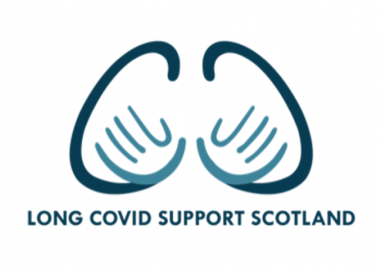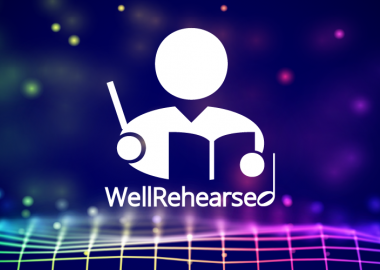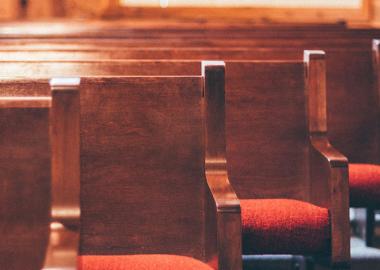We hear from groups about how they have managed to put on risk-assessed, COVID-secure performances for their audiences.
Putting on a COVID-secure performance: Grayshott Concerts | Putting on a COVID-secure performance: Norwich Chamber Music
Witney Music Society in Oxfordshire hosts 6 evening concerts a year at High Street Methodist Church in Witney. Concerts are on the second Friday of each month, and the season lasts from October to March. In the 2019-20 season, we had approx. 125 subscribers, each paying £50 for a season ticket. Tickets on the door cost £12 and the average audience size was 170.
What was your group’s initial reaction when lockdown was introduced in March?
We managed to have the last concert of the 2019-20 season just before lockdown began, so we had time on our side as we were then on a break until October. Of more immediate concern was our AGM, which we held outdoors and in person during the summer, when social distancing guidelines allowed.

When did you start to look ahead to future concerts, and what were your considerations?
During the early summer we held several committee discussions as there was concern about what we could and couldn’t do. There was a trade-off between what we wanted and what was realistic, with little certainty in predicting what would be happening in October. We felt it was important to do what we could to keep our loyal local following.
Our venue took a long time (till mid-September) deciding when to re-open. It’s a busy venue so being COVID-secure was a big concern for them. For us there were no other venue options – it was there or nowhere. We did some thinking ahead but we needed to wait for the venue’s risk assessment document before starting detailed planning.
We looked at streaming, but we wanted the performance to be live and there was no technological capability at the venue to set up a livestream. We asked the artists we had booked for the first half of the next season how they felt about pre-recording; although they were not against it in principle, they said that they weren’t sure they’d have somewhere suitable to make such recordings. Our audience indicated that they would strongly prefer a live performance.
We knew from the start that whatever form the concerts took, we would lose money on them. Because the society had been doing well financially and has good reserves, we were prepared for this and were willing to do it for the sake of both our audience and the artists.
Because we couldn’t guarantee putting on a full season of concerts, we realised that we couldn’t offer our usual subscription and instead had to change the model altogether. Under our new model we decided to charge £5 to be a member, which then allowed priority booking on tickets. Initially 85 people signed up as members; some knew they’d be unlikely to attend any performances and signed up just to support us.
Very early on we made the decision to postpone the performers for the first concert (a wind quintet plus piano) to a date in 2021. This was because we felt it would be too much of a challenge for us to organise under COVID-secure conditions. Instead we specifically booked a local solo guitarist to make things as simple as possible – we didn’t need to worry about his travelling to the venue, or about providing him with food, because he could eat at home prior to arriving. We negotiated a flexible agreement with his agent, with the understanding being that it would be either a full-length concert, a shorter concert, or no concert at all, depending on the situation in October.
We looked at streaming, but we wanted the performance to be live and there was no technological capability at the venue to set up a livestream. Our audience indicated that they would strongly prefer a live performance
What other details did you need to consider in planning a COVID-secure performance?
We visited the venue specifically to consider it from a COVID perspective. In mid-September, our venue confirmed that we would be permitted to hold our October concert there and they sent us their risk assessment document. We had to send them ours by 1 October. To create this, we used the Making Music risk assessment template, along with risk assessment documents from the venue and from another local arts organisation. Before giving their approval, the venue requested some minor changes regarding responsibility for some of the cleaning on the concert evening. The risk assessment document for the October concert covered most aspects of the concerts there, but a slightly more extended document was written and published to deal with more complex arrangements including piano tuning and transport issues for later concerts in the season.
Further to a small-scale mailing about the AGM, we did one full-scale mailing in September with a letter about what we were thinking of doing for the forthcoming season. To reduce our costs, we produced a one-page season flyer instead of our usual 16-page season brochure (which previously ran to 1,800 copies, distributed around West Oxfordshire) and arranged for our flyer and mailing letter to be printed together. Just under 200 of these letters went out by post, and because the local company who normally post our mailshots pro bono were closed due to lockdown, we did it all ourselves.
We knew from the start that whatever form the concerts took, we would lose money on them. Because the society had been doing well financially and has good reserves, we were prepared for this and were willing to do it for the sake of both our audience and the artists
What worked well and what concerns did you have at your COVID-secure performance?
Things that went well:
-
We only accepted advance bookings with pre-payment for the concert. We really stressed this in all our concert publicity and communications beforehand because our audiences are used to the idea of just being able to turn up. We were concerned we might get people trying to ‘walk in’, but no one did, so our messaging was effective.
- The venue laid out the seating, spacing out single and double seats in a semi-circular fashion.
- Our capacity was limited because of the socially-distanced seating, and we sold out the concert (60 people).
- We implemented a one-way system, closing the entrance from the car park so that everyone had to come in through the front door. This single entrance point meant that the treasurer could check everyone as they entered to ensure that they had a pre-paid reservation.
- At the end of the concert, we opened both sets of doors and directed people to leave in a specific order to prevent them from having to walk past each other.
Areas of concern:
- To prevent walk-ins, we had to keep the external doors closed, which meant that they couldn’t be used for ventilation during the concert. To mitigate this, we had the windows open all day prior to the performance.
- Face coverings were a concern. We’d already told one enquirer that they couldn’t wear a visor instead of a mask, but we knew that there was a possibility that people might arrive with no mask and claim medical exemption. We had spare masks available for anyone who had forgotten theirs and we ensured that people on the door were aware of the rules. On the day, this turned out not to be an issue as only one person arrived without a mask (and that was inadvertent).
- Biggest challenge: we knew that we were responsible for ensuring that what we were offering to our audience was the best that we could do and – more importantly – would be safe. We got a fabulous response on the night, and afterwards, with people saying they were so pleased to be able to leave the house and attend an event.
Seeing as we are now in a second lockdown, the November concert will be on YouTube, broadcast from a music college in London.
What top tips would you give to anyone planning a COVID-secure performance?
Have all your committee on board. On the evening of the concert, having plenty of committee members greeting everyone cheerfully and efficiently helped the audience feel welcomed and safe.
Ensure all messaging is really clear and consistent. Our protocols were made available on the website and the same message was also sent by email when people booked tickets.
Be prepared for the fact that a socially-distanced concert will result in much reduced ticket sales and will therefore almost inevitably lose money. We were aware of this from the start but agreed that both for our members and the artists it was important to keep the live concerts going, if at all possible. Overall, the loss of income was more than compensated for by the amount of goodwill generated by the event.
Putting on a COVID-secure performance: Grayshott Concerts
Putting on a COVID-secure performance: Norwich Chamber Music
We hope you find this Making Music resource useful. If you have any comments or suggestions about the guidance please contact us. Whilst every effort is made to ensure that the content of this guidance is accurate and up to date, Making Music do not warrant, nor accept any liability or responsibility for the completeness or accuracy of the content, or for any loss which may arise from reliance on the information contained in it.










